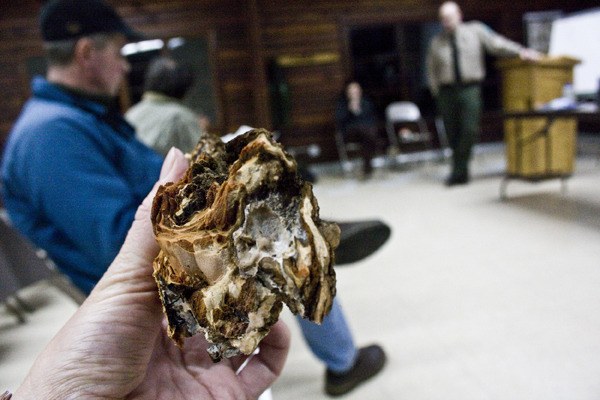Douglas firs fall without warning when their roots are rotted, and measuring 40 inches and weighing more than several tons, these giants can cause damage when they hit the ground, especially when campers are in the area.
Rob Fimbel with the Washington State Parks’ Stewardship Program doesn’t know exactly how many trees have fallen at Moran State Park because of laminated root rot, a native species of fungus, but describes infected trees as ticking time bombs.
“And fall when? I don’t know when,” Fimbel said. “The problem with this disease is when people are in proximity, there is an elevated risk.”
To deal with the dangers of falling trees, Fimbel has proposed a plan to patch cut and thin three areas of the park, which include the surrounding areas of the Environmental Learning Center, the primitive campground and the upper part of the north end campground. The areas are high priority because of the year-round and seasonal living quarters by the ELC and the overnight guests at the campgrounds.
At a public meeting on Feb. 15, Fimbel presented a map, where trees infected with laminated root rot could be cut down in order to starve the pathogen. Some of the cut Douglas fir could be sold as timber, and Fimbel said any revenue from this will go to natural resources stewardship efforts.
“It’s moving,” he said pointing to the map. “This thing is marching on.”
History
In the spring of 2011, a Department of Natural Resources pathologist was called in for a consultation; as a result of his recommendations, the north end campground was closed for the summer. The park had to refund previous reservations, or make room elsewhere for anticipated guests. In addition, the cabins around the ELC were closed.
Roughly 50 Douglas fir trees around the ELC and portions of the north campground upper loop were logged in July because they were infected with laminated root rot. Some of the felled forest giants were over 100 years old.
Three trees fell behind the ELC about two weeks ago with very small root balls, said Park Manager Jim Schuh.
Fimbel said he had no reason to doubt that those trees failed because of the fungus. Trees fail for a number of different reasons, like strong storms, but when they fail because of laminated root rot, they typically have very small root bulbs, according to Fimbel.
The fungus
The fungus spreads by root-to-root contact between trees, but does not spread through soil or air on its own. It can remain viable in stumps for up to 50 years, infecting any new trees of species susceptible to the disease.
There is concern that adjacent trees that do not show symptoms may be in an early and undetectable stage of the disease.
Fimbel said the fungus may have been kept in check in an earlier time because historically the forest was more diverse and there could have been more hardwoods – broad-leaved deciduous trees, that stopped the pathogen, which spreads 1 to 2 feet a year.
Douglas fir, mountain hemlock, western hemlock, grand and Pacific silver fir are all considered “highly susceptible” to the disease, according to a “Forest Notes,” prepared by the DNR extension science program for Washington State University.
Douglas fir is the perfect host — its roots grow together for strength, but it works the opposite for laminated root rot because those roots create a highway network for pathogens.
Fimbel sees the resolution to the rot problem as one of two options.
“We could retreat and abandon infrastructure in those areas and discourage people to spend too much in those areas, especially camping,” Fimbel said. “Or we can contain and control.”
He said thinning and patch cuts would give non-host trees more room to grow around the primitive campground and the ELC. Stumps would be left in the ground in the proposed plan because removing them disturbs the soil and doesn’t guarantee to get rid of pathogens, said Fimbel. He also plans to replant trees, like lodgepole pine, that are resistant to the fungus.
Fimbel hopes to implement this plan by April, and have areas around the ELC and campgrounds open by Memorial Day, but is waiting for the approval of the director of Washington State Parks.
Fimbel said that the idea of cutting down trees has been hard for people to digest even if it is for the greater health of a forest area, but he said people are becoming open to the idea.
“It’s 12 acres out of 5,000 that will be left untouched and 38 miles of trails leaving as is,” Schuh said. “These areas pointed out, where we are inviting people to stay overnight, are where we have to balance risk versus benefit to trees.”
For more info, visit parks.wa.gov/plans/separeviews, or contact the park at moran@parks.wa.gov or 376-2326.




